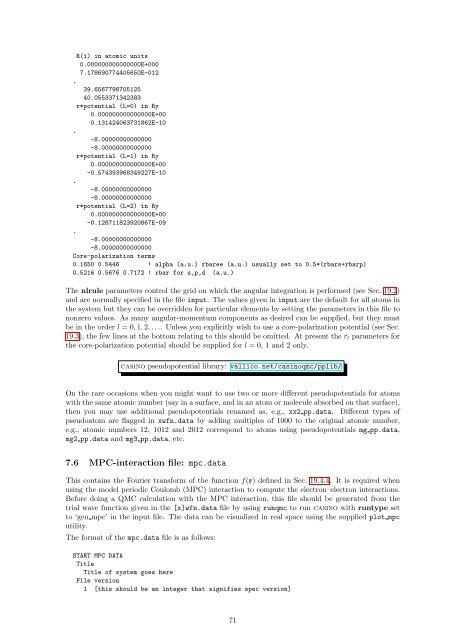CASINO manual - Theory of Condensed Matter
CASINO manual - Theory of Condensed Matter
CASINO manual - Theory of Condensed Matter
Create successful ePaper yourself
Turn your PDF publications into a flip-book with our unique Google optimized e-Paper software.
R(i) in atomic units<br />
0.000000000000000E+000<br />
7.178690774405650E-012<br />
.<br />
39.6567798705125<br />
40.0553371342383<br />
r*potential (L=0) in Ry<br />
0.000000000000000E+00<br />
0.131424063731862E-10<br />
.<br />
-8.00000000000000<br />
-8.00000000000000<br />
r*potential (L=1) in Ry<br />
0.000000000000000E+00<br />
-0.574393968349227E-10<br />
.<br />
-8.00000000000000<br />
-8.00000000000000<br />
r*potential (L=2) in Ry<br />
0.000000000000000E+00<br />
-0.128711823920867E-09<br />
.<br />
-8.00000000000000<br />
-8.00000000000000<br />
Core-polarization terms<br />
0.1650 0.5446 ! alpha (a.u.) rbaree (a.u.) usually set to 0.5*(rbars+rbarp)<br />
0.5216 0.5676 0.7172 ! rbar for s,p,d (a.u.)<br />
The nlrule parameters control the grid on which the angular integration is performed (see Sec. 19.2)<br />
and are normally specified in the file input. The values given in input are the default for all atoms in<br />
the system but they can be overridden for particular elements by setting the parameters in this file to<br />
nonzero values. As many angular-momentum components as desired can be supplied, but they must<br />
be in the order l = 0, 1, 2, . . .. Unless you explicitly wish to use a core-polarization potential (see Sec.<br />
19.3), the few lines at the bottom relating to this should be omitted. At present the ¯r l parameters for<br />
the core-polarization potential should be supplied for l = 0, 1 and 2 only.<br />
casino pseudopotential library: vallico.net/casinoqmc/pplib/<br />
On the rare occasions when you might want to use two or more different pseudopotentials for atoms<br />
with the same atomic number (say in a surface, and in an atom or molecule absorbed on that surface),<br />
then you may use additional pseudopotentials renamed as, e.g., xx2 pp.data. Different types <strong>of</strong><br />
pseudoatom are flagged in xwfn.data by adding multiples <strong>of</strong> 1000 to the original atomic number,<br />
e.g., atomic numbers 12, 1012 and 2012 correspond to atoms using pseudopotentials mg pp.data,<br />
mg2 pp.data and mg3 pp.data, etc.<br />
7.6 MPC-interaction file: mpc.data<br />
This contains the Fourier transform <strong>of</strong> the function f(r) defined in Sec. 19.4.4. It is required when<br />
using the model periodic Coulomb (MPC) interaction to compute the electron–electron interactions.<br />
Before doing a QMC calculation with the MPC interaction, this file should be generated from the<br />
trial wave function given in the [x]wfn.data file by using runqmc to run casino with runtype set<br />
to ‘gen mpc’ in the input file. The data can be visualized in real space using the supplied plot mpc<br />
utility.<br />
The format <strong>of</strong> the mpc.data file is as follows:<br />
START MPC DATA<br />
Title<br />
Title <strong>of</strong> system goes here<br />
File version<br />
1 [this should be an integer that signifies spec version]<br />
71

















